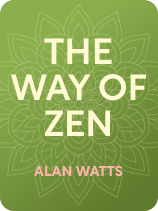

This article is an excerpt from the Shortform book guide to "The Way of Zen" by Alan Watts. Shortform has the world's best summaries and analyses of books you should be reading.
Like this article? Sign up for a free trial here.
How is Zen Buddhism different from traditional Buddhism? How does it view awakening and meditation? What are wu-hsin and dhyana?
Zen borrowed several concepts from earlier traditions, and it developed some of its own philosophies. That makes it a unique offering in Eastern thought. Alan Watts explores the ideas that differentiate Zen from other schools of Buddhism.
Continue reading to learn about the three primary distinctions of Zen Buddhism.
How Is Zen Buddhism Different?
While Zen was built on what came before, it’s a unique school of Mahayana Buddhism with many original ideas. How is Zen Buddhism different from traditional Buddhism? The most important differences are its directness (in awakening and in teaching), its stance on meditation, and its principles about how you should use your mind.
Awakening Is Direct and Instantaneous
The first idea unique to Zen is its understanding of the nature of awakening. In other schools of Buddhism, you might have to work a lifetime to achieve awakening. But in Zen, awakening is immediate and can happen anytime. Watts explains that you don’t have to pass through a sequence of spiritual stages or spend your days in meditation to get there. Instead, awakening can occur instantaneously, an experience called satori. Zen teaches that you can experience awakening in everyday activities like working, creating art, and appreciating the natural world.
The point of Zen is not to experience awakening or to attain Buddhahood because you are already a Buddha by nature. To try to become a Buddha is to deny that you already are a Buddha. Additionally, Watts writes that you can develop prajna, a kind of direct knowledge or wisdom. The principle of prajna is that by seeing the relativity of everything (including the futility of the pursuit of goals), we come to know the truth of the world by not knowing it.
(Shortform note: Though Watts may make it sounds like satori happens without effort, that’s not how everyone interprets the principle. Novelist and Zen teacher Peter Matthiessen—who studied Rinzai Zen, the school of Zen that emphasizes sudden awakening, and wrote Zen-inflected books such as The Snow Leopard—explains that the heart of Zen is za-zen, a meditation practice in which you sit in silence and bring your attention to the present moment, often by focusing in on your breath. Similarly, Buddhist teacher Andy Karr writes that sudden enlightenment typically comes after a long journey; for most people, the process of developing prajna requires studying, contemplating, and meditating on Buddhist teachings.)
Zen Can Be Communicated Directly, Without Symbols
The second concept unique to Zen is its directness. Watts writes that Zen is unusually direct in the way it teaches and communicates. The Zen method of instruction, called wen-ta or the “Zen story,” typically takes the form of an anecdote where a question is asked and then answered. These stories aim to point the listener toward a realization, but they aren’t symbolic: The characters don’t represent something else, and there’s no metaphor.
(Shortform note: The directness of Zen contrasts with the abstraction we’ve become accustomed to using when we experience the world. Pico Iyer, the author of The Lady and the Monk, writes that because of its directness in thought and teaching, Zen Buddhism is known for “slicing with a clean sword through all the Gordian knots invented by the mind.” But while directness can sound appealing, it can also make Zen very counterintuitive. A saying attributed to Bodhidharma suggests that the teachings of Zen are independent of language and instead point directly to the human mind. Therefore, you can perceive your true nature and Buddhahood not through studying Zen, but by experiencing the true nature of the world in meditation.)
Watts explains that the directness of a Zen story is typical of Zen’s directness in communication. A method of conveying insight called “direct pointing” involves demonstrating a Zen principle through words or actions that don’t overtly comment on the question in the story. For example, Watts explains that according to Zen tradition, the Buddha simply held up a flower to communicate awakening to his disciple Mahakasyapa—a famous example of direct pointing.
(Shortform note: The idea of nonsymbolic communication sounds paradoxical. In Pointing at the Moon, Mario D’Amato writes the Buddha is thought not to have used language in the way it’s ordinarily used: The enlightened use of language involves “use,” but not “reference.” Zen Buddhist priest Norman Fischer writes that the Buddha holding up a flower “would be enough to evoke all teachings, all truths” to transmit nirvana—because there’s nothing to transmit.)
You Don’t Have to Control or Empty Your Mind
A third idea core to Zen’s teachings is the principle of wu-hsin, or “no-mind.” Building on the Taoist philosophy of naturalness, the principle of wu-hsin suggests that, instead of trying to still, empty, or purify your mind, you should let go of your control of the mind itself.
Watts writes that, when you combine wu-hsin, or “no mind,” with wu-nien, or “no thought,” you free your mind to act while thinking, without trying to second-guess or control it. The point of this un-self-consciousness is not to be unaware of what’s happening around you or within you, but to shift your attention away from conscious cognitive processes and toward a spontaneous and creative state. This involves just observing thoughts come and go, without suppressing them, holding onto them, or trying to interfere with them.
(Shortform note: Much of Western thinking about mindfulness, including its emphasis on observing but not controlling your thoughts, is derived from Zen Buddhism and the concepts of wu-hsin and wu-nien. In Wherever You Go, There You Are, Jon Kabat-Zinn draws a distinction between thinking and the awareness required in mindfulness. He explains that thinking involves actively engaging with the flow of feelings and thoughts you experience, while mindfulness requires stepping back from those thoughts and feelings to simply observe them.)
According to Watts, Zen became a new school of Buddhism because it took a new and unique view of dhyana, a concept that Watts notes is often but inadequately translated as “meditation.” He explains that dhyana might be better understood as a state of awareness that’s focused on the present and unconstrained by false boundaries between “the knower, the knowing, and the known.” In other words, Zen teaches that, when we enter a state of dhyana, we look beyond conventional separations to see the world for what it is.
| How Does Science Interpret the Experience of Dhyana? Scholars, including scientists, offer multiple ways to interpret dhyana. Tim Lott writes that this Sanskrit word signifies emptiness. He explains that the basis of Zen is the idea that all of existence has a kind of “dynamic emptiness,” where matter and energy are the same and objects aren’t so much things that exist as events that happen. Lott points out that this squares with a modern scientific understanding of quantum physics (which some experts say posits a kind of emptiness where objects and events are just temporary and quantum particles blink in and out of existence, only manifesting in space-time when there’s an observer). Watts’s explanation of dhyana as a state of awareness unconstrained by boundaries might also call to mind phenomena explored in neuroscience. The experience of dhyana he describes in some ways parallels the experiences of people who have undergone brain traumas localized to one hemisphere of the brain. In My Stroke of Insight, Jill Bolte Taylor writes that when she had a stroke in her left hemisphere, her left brain’s capacity for logic and judgment was silenced while her right brain’s capacity for empathy and stillness was heightened. Taylor explains that, to the right brain, there’s no sense of time, there aren’t boundaries but relationships to observe, and there are no value judgments to dismiss new experiences. The right brain perceives itself and the world as on a continuum, rather than composed of separate entities (just as Watts writes that dhyana does away with the boundaries among the knower, the knowing, and the known). Taylor concludes that we all have the brain circuits to feel the sense of connection she experienced—which may be something like dhyana. |

———End of Preview———
Like what you just read? Read the rest of the world's best book summary and analysis of Alan Watts's "The Way of Zen" at Shortform.
Here's what you'll find in our full The Way of Zen summary:
- The major principles and history of Zen Buddhism
- How to experience Zen in everyday life—without a strict meditation practice
- Why calling Zen a "practice" is a mistake






